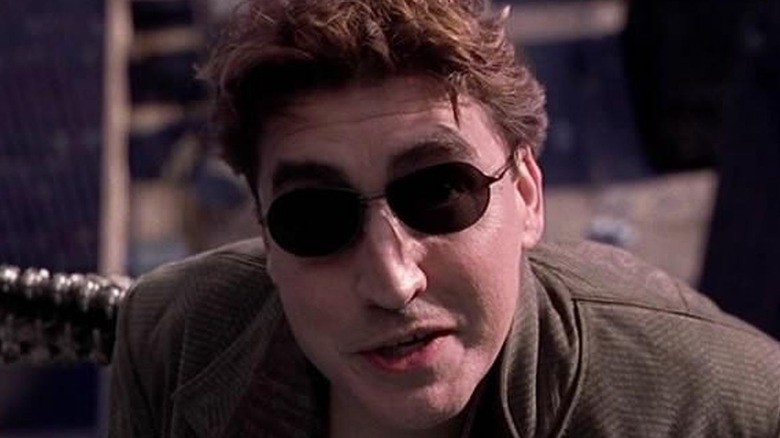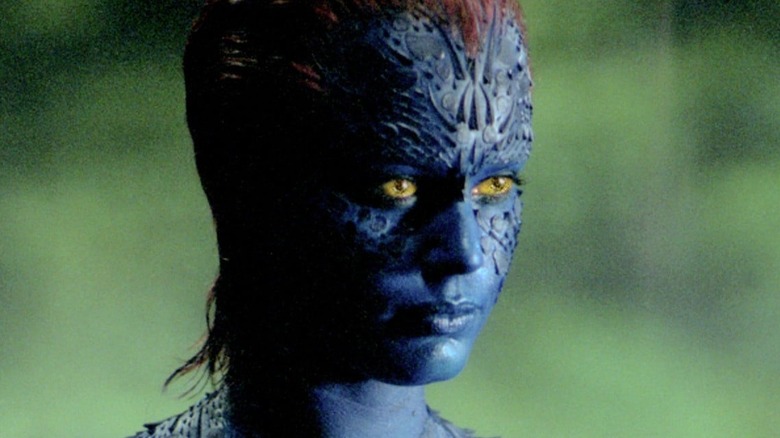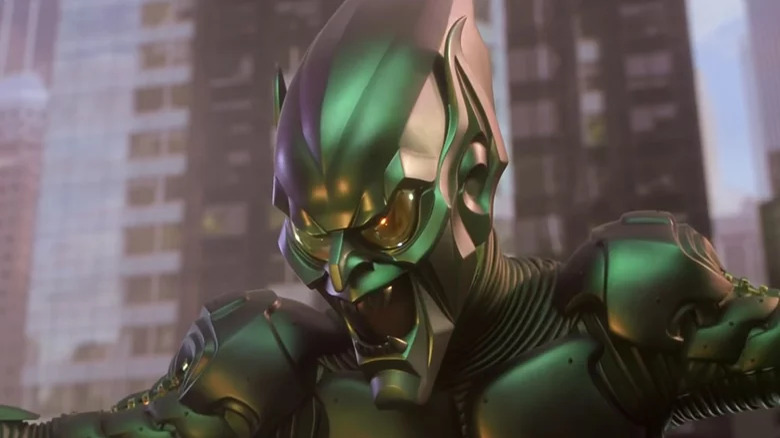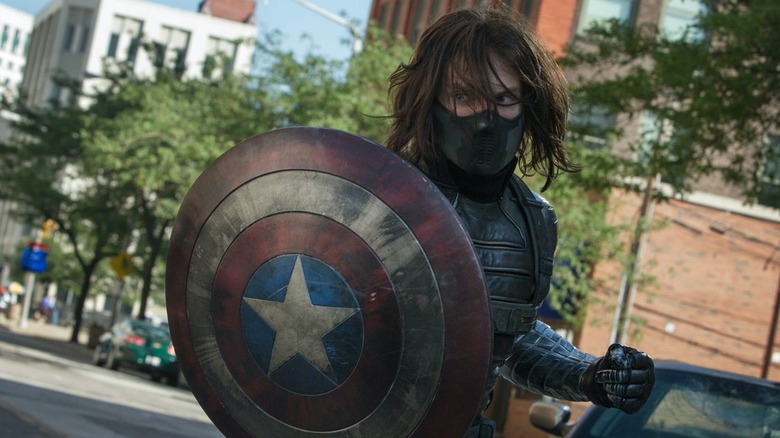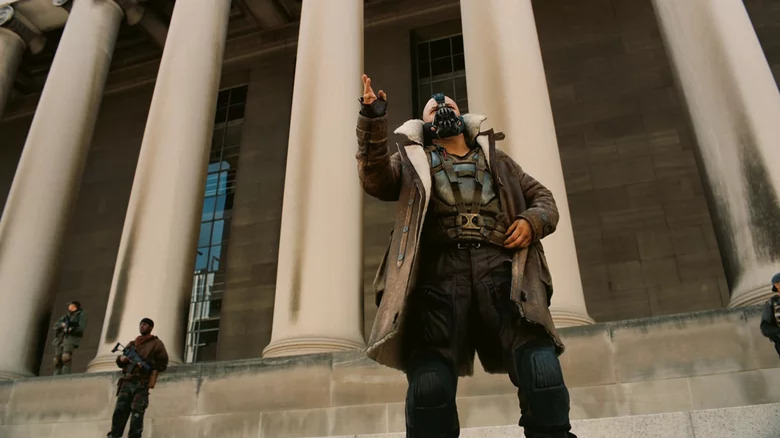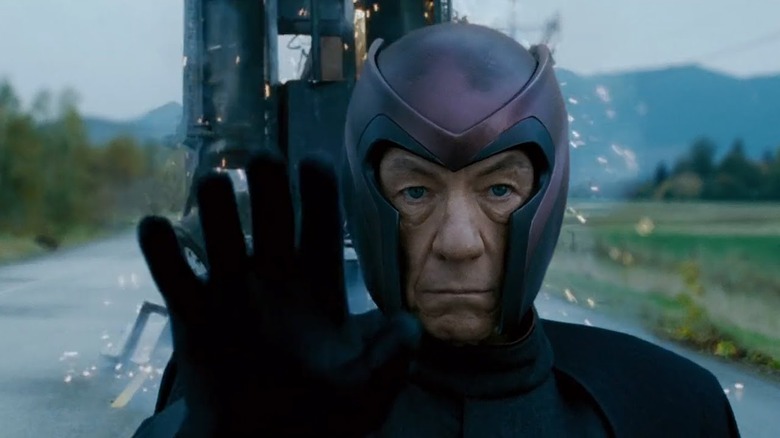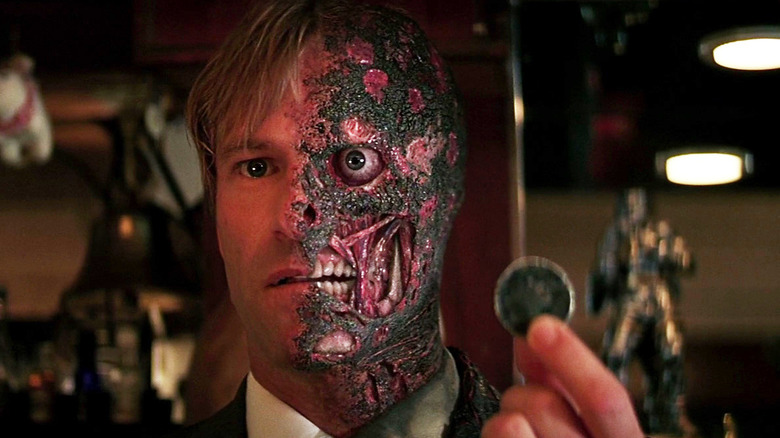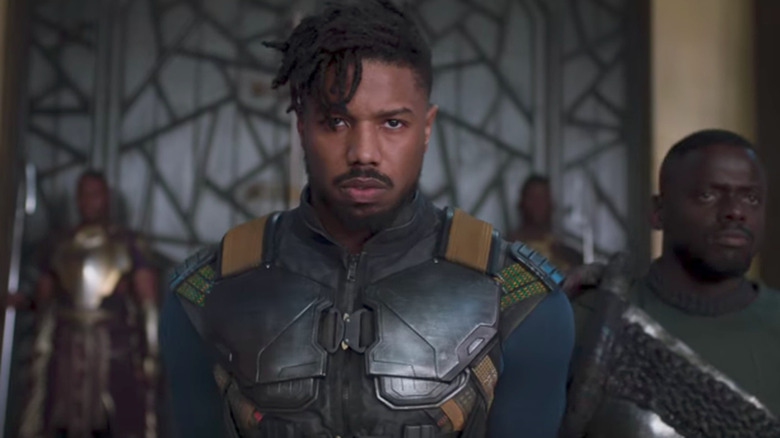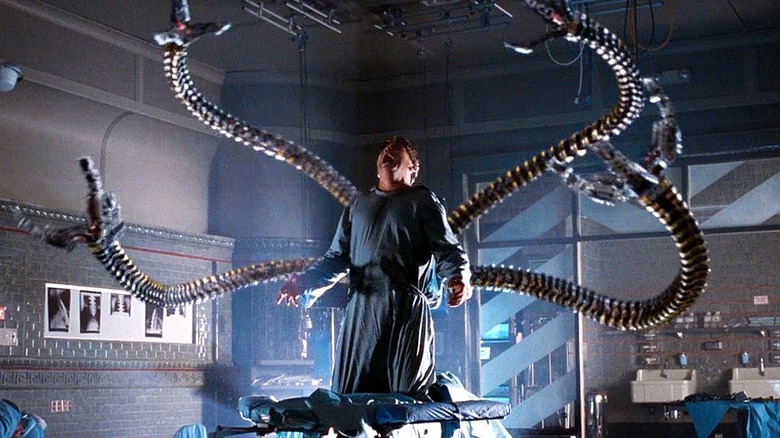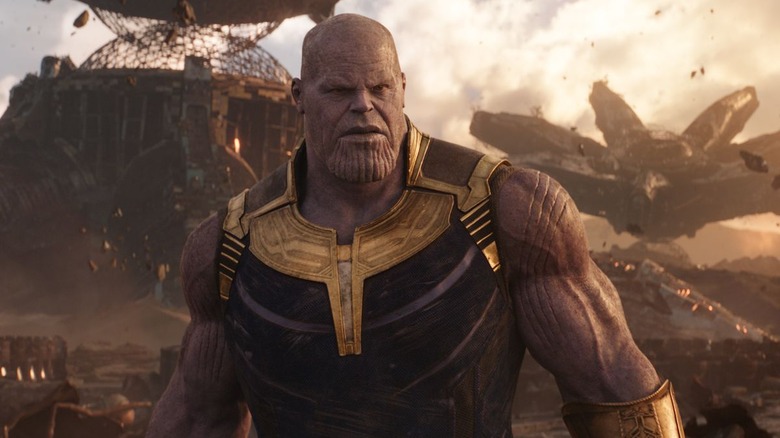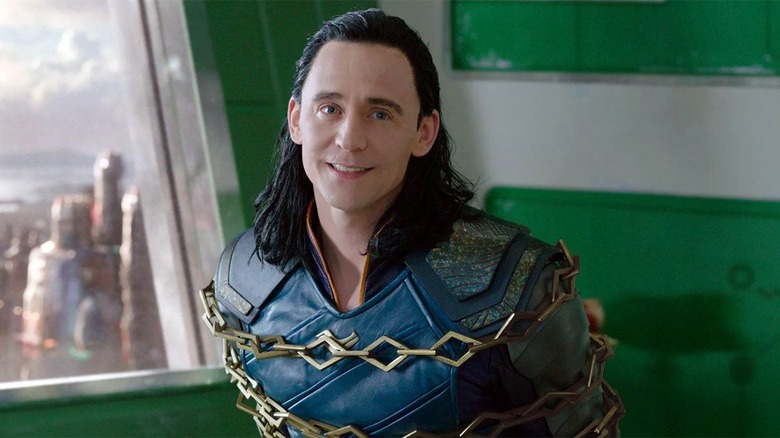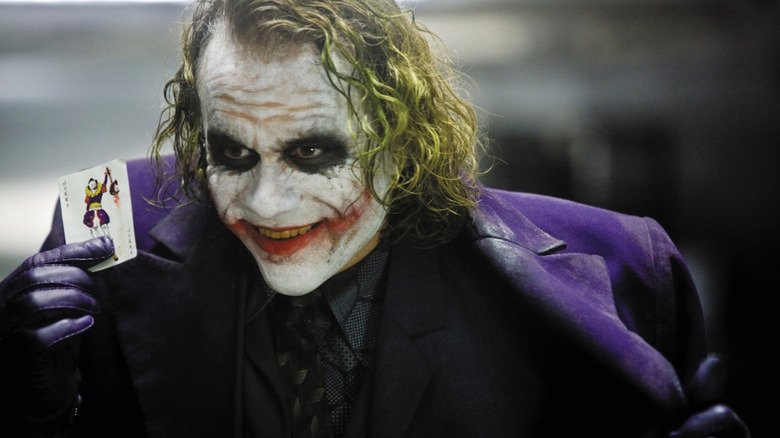The Best Superhero Movie Villains Of All Time
What's a superhero without a supervillain to challenge them? Boring, that's what. Supervillains are an integral part of the superhero movie formula. If the movie doesn't nail it with a baddie, the hero's arc is undermined. And let's be honest, there's been no shortage of lousy movie supervillains over the years. Some are boring, paint-by-numbers alien baddies who hate the good guys just because. They want to conquer or destroy the world because, well, they're bad guys and that's just what bad guys do. Some superhero movies have survived bad villains, but it takes a lot of unnecessary effort to pull it off.
But fortunately for us, there have also been plenty of excellent superhero movie villains over the years. The ones who terrify and entertain, avoid lazy tropes, have an understandable point of view, and, in the best films, force the heroes to grow as characters in order to be victorious. So which ones are the best? We've assembled them here.
Mystique
The original "X-Men" movies introduced us to no shortage of timeless supervillain baddies, like Magneto, Sabretooth, and Colonel Stryker. But their most unique antagonist has to be Mystique.
First played by Rebecca Romijn, this all-blue, scaly-skinned, yellow-eyed mutant baddie is a world-class shapeshifter. And she knows this skill inside and out. It's useful for infiltration, stealth, and manipulation: She is an expert at getting into the heads of her foes by looking and sounding exactly like someone they love or fear. But stopping her isn't as easy as seeing past the ruse. She's also an Olympic-level acrobat and a lethal hand-to-hand combatant, giving other mutants a run for their money in a fight despite lacking laser vision or unbreakable metal claws. She can flip, hand-spring, punch, and kick her way out of almost any situation, making her one of the most uniquely dangerous and fascinating villains in superhero movie history.
In the newer "X-Men" movies, starting with "First Class," a younger Mystique is played by Jennifer Lawrence, who took her from a somewhat flat baddie to a fully fleshed-out character. Lawrence's Mystique retains all the otherworldly dangers we associate with the shapeshifter while adding emotional weight to her backstory and motivations. She doesn't start off evil, but is simply trying to survive in a world that hates her, just like every other young mutant.
Green Goblin
Sam Raimi's "Spider-Man" movies might've had their legacy damaged by an unfortunate final film, but the first two hold up better than you might think. Both introduce villains who are threats to Spider-Man when they're in costume, and Peter Parker when they're dressed as civilians. Norman Osborn, also known as the Green Goblin, is the perfect example of this.
Played chillingly by Willem Dafoe, Osborn is the wealthy father of Peter's best friend and a famed New York industrialist. He starts on the path to villainy when his passion project — a super-soldier serum and combat suit technology — is at risk of losing military funding. To push his research along, Osborn takes the serum himself, ignoring warnings from the lab that the formula isn't ready. He's given superhuman strength and heightened senses, but is also driven insane with rage.
He then dons a terrifying, demonic mask from his personal collection (which conveniently happens to be the exact same color as the glider suit) and embarks on a killing spree across New York, first targeting the naysayers at his company, and then Spider-Man, who tries to stop him. When he learns Spider-Man's identity, he targets Peter himself, as well as those he loves, like Aunt May and Mary Jane. Dafoe nails the role with all the cackling, delightful menace you could possibly want.
Winter Soldier
Any issues that might've plagued 2011's "Captain America: The First Avenger" were all solved in 2014's "Captain America: The Winter Soldier." This movie, in which Steve Rogers becomes a fugitive after discovering that S.H.I.E.L.D. has been infiltrated by Hydra villains, is a nonstop thrill ride with thought-provoking themes, sharp writing, and some of the best fight scene choreography in recent memory.
One of the best parts about it, on paper, shouldn't have worked at all: Nothing is a bigger superhero story cliché than a dead character coming back to life. But the reveal that the Winter Soldier, a nearly unstoppably violent assassin operated by Hydra, is actually Bucky Barnes comes as a genuine surprise to anyone unfamiliar with the comics. It is certainly a shock for Steve Rogers, who makes it his life's mission to save his long-lost friend.
Any doubts that Bucky couldn't be the center of two Captain America movies were put to bed with the reveal that he killed Tony Stark's parents, leading to the final split between Tony and Steve in "Captain America: Civil War." Because man, when he's brainwashed, Bucky is more than a match for Black Widow, Falcon, and Captain America put together. We're simply too scared not to include him.
Bane
"The Dark Knight" was such a hit that it was impossible for the 2012 sequel, "The Dark Knight Rises," to live up to the hype. Wisely, writer-director Christopher Nolan decided to take the franchise in a new direction entirely for its final film, in which a jaded, noticeably older Bruce Wayne returns as Batman to save Gotham from a terrorist who's holding it hostage with a nuke.
In "Batman Begins," the Caped Crusader is challenged by his own inexperience as Gotham is besieged by multiple villains simultaneously. In "The Dark Knight," the Joker and Two-Face hit Batman in both the heart and mind, challenging his reliance on physical strength to dominate his foes. But in "The Dark Knight Rises," Batman is challenged physically by the cold, brute power of Bane (Tom Hardy), a masked terrorist who is so violent and ideologically extreme that the League of Shadows itself — which trained Batman and nearly destroyed Gotham — excommunicated him.
Bane viciously beats an aging, out-of-practice Batman, breaking his back and imprisoning him on the other side of the world while he launches a revolution and seizes control of Gotham. Although he is ultimately a mere pawn of Talia Al Ghul, Tom Hardy's performance, physicality, and haunting voice keep him comfortably on this list.
Magneto
Before the MCU, the "Dark Knight" movies, and even the Sam Raimi "Spider-Man" trilogy, there was the first "X-Men": A film from 2000 that follows Hugh Jackman's Wolverine as he meets Patrick Stewart's Professor Xavier for the first time. This movie gives us our first look at Magneto, an old mutant who can control metal with his mind (thus making him a serious threat to Wolverine, whose skeleton is coated in indestructible adamantium) and whose childhood experiences in the Holocaust gave him deep trauma. His philosophy — that mutants should fight for their place in the world even if it requires violence against humans — puts him directly at odds with his old friend Xavier, who believes the best way to achieve harmony with humans is to work with and protect them.
Over the course of the series, the apocalyptic nature of the threats the mutants face (one of which is actually named Apocalypse) forces Magneto and the X-Men to cooperate. But whether they're at odds, reluctantly working together, or somewhere in between, it doesn't change the fact that Magneto and Professor X have incompatible ideologies. Both Ian McKellen and Michael Fassbender never fail to bring Shakespearean gravitas and calculating wisdom to the role, making their Magneto one of the most enduringly rewatchable supervillains of all time.
Two-Face
It's been said before that Christopher Nolan's "The Dark Knight" isn't a superhero movie so much as, as the Rotten Tomatoes critics consensus puts it, "a richly thrilling crime saga" that happens to involve comic book characters. Its structure aligns more with movies like "Heat" and other cop-and-robber flicks than "Iron Man" or "X-Men."
We're first introduced to Aaron Eckhart's idealistic district attorney Harvey Dent as Rachel Dawes' new love interest, much to Bruce Wayne's dismay. But when he hears Dent wax lyrical about the nature of justice and righteousness, Wayne decides Dent is the successor that he's been searching for. With a public servant like Dent rounding up Gotham's crooks, who needs Batman?
But we all know what happens next. The Joker orchestrates a masterstroke of a plan to break the spirit of his foes. Rachel dies, and a devastated Harvey is severely disfigured. The Joker busts him out of the hospital before blowing it up, and Dent — now Two-Face, who decides if his victims live or die with a coin toss — embarks on a killing spree to avenge Rachel's death, setting up a devastating but brilliant conclusion to the film.
Killmonger
If you want a villain to be memorable, make them right. That's what "Black Panther" co-writer/director Ryan Coogler and actor Michael B. Jordan understood when they created Erik "Killmonger" Stevens, the cousin of King T'Challa who wants to seize control of Wakanda for himself. He believes that T'Challa is a weak king who, despite having abundant resources and power, is neglecting Black people around the world, many of whom live in poverty or under unjust systems. Under Killmonger's rule, Wakanda would essentially bankroll and supply armed revolutions of oppressed people around the globe.
He challenges T'Challa to combat and wins by throwing the king over a waterfall to his presumed death, making him the new king. However, T'Challa isn't dead, just wounded, and his return instantly delegitimizes Killmonger's regime and leads to civil war. Killmonger's revolution fails before it begins, with a mortally wounded Killmonger pulling the spear out of his chest and asking T'Challa to bury him at sea with their ancestors who "jumped from the ships" because they knew that "death was better than bondage."
Killmonger is dangerous, but the issues he sought to address are very real, so much so that they inspire a reinstated King T'Challa to reveal Wakanda's advanced nature to a world in need.
Doctor Octopus
Other than Batman, Spider-Man has the deepest rogues gallery in comics. Many of these villains have graced the movies at one point or another, but Alfred Molina's performance as Doctor Otto "Doc Ock" Octavius is one of the best Spidey supervillain portrayals in movie history.
In "Spider-Man 2," Peter Parker meets Octavius and is fascinated by a nuclear fusion reactor he's built — rather unwisely, it turns out — which he operates with mechanical arms attached to his spinal column. During a demonstration for the press Peter attends, the reaction becomes unstable and destroys the lab, killing Otto's wife, fusing the arms to his nervous system, and forcing Peter to leap into action as Spider-Man to shut the project down. The fusing of the arms to Otto's brainstem means they can influence his thoughts. They eventually convince him to restart his project using stolen funds, which, of course, puts him at odds with Spider-Man.
Molina poured so much heart and soul into his performance that you can't help but sympathize with him. The ending, where Octavius snaps out of it and destroys his new reactor, saying "I will not die a monster," is one of the most powerful superhero movie conclusions ever.
Thanos
Building up to an important character can be something of a double-edged sword. On the one hand, it operates like any mystery should, keeping audiences hooked and ensuring high viewership for the big reveal. On the other hand, if a character doesn't live up to the hype, it can sink the whole project.
The risk was huge when it came to Thanos. The first three phases of the MCU deal with Infinity Stones, which fans of the comics knew meant the Mad Titan and his universe-ending Infinity Gauntlet would be making an appearance sooner or later. Many movies, like "The Avengers" and "Guardians of the Galaxy" have Big Bads who work for an off-screen Thanos or strike a deal with him. He provides Loki with the alien army seen at the Battle of New York, commands Ronan the Accuser, and generally casts a large shadow over the galaxy, despite the audience only getting minimal glimpses and whispered hints about who he is.
Luckily, when he finally arrives in 2018's "Avengers: Infinity War," he is everything we hoped he'd be. Huge, terrifying, cold, calculating, and surprisingly empathetic, Josh Brolin brings deep, chilling gravitas to the character who is a believable match for our heroes. Defeating him in "Endgame" brings everyone close to their breaking point, but it also brings out the best within them. What more can you want from a villain?
Loki
The first two "Thor" movies provide an opportunity for two of the most important components of the MCU to emerge: Chris Hemsworth in the starring role of the hammer-wielding Norse god, and Tom Hiddleston as his mischievous adopted brother, Loki.
It's often been said that the MCU has a bit of a villain problem, especially when the franchise was just getting started. Many baddies are forgettable and flat, usually motivated by little more than hatred for the heroes and an appetite for conquest. But Loki — colorful, unpredictable, funny, mysterious, and quotable — is a delightful exception to that rule. Luckily, the big wigs at Disney picked up on his potential after the first "Thor" movie and graced us with his scene-stealing presence in five other films, including three of the big team-up "Avengers" movies, as well as appearances in "What If?" on Disney+ and his own excellent TV series, in which he's turned into something of an antihero. It's amazing that Loki — a selfish and manipulatively charming demigod who himself was once plagued by supervillain cliches — breaks the mold and becomes an irreplaceable part of the MCU.
Joker (Ledger)
What more can be said about Ledger's unforgettable, Oscar-winning performance as the Joker? It caused a sensation, and is further elevated by the fact that it exists in Christopher Nolan's "The Dark Knight," one of the best superhero films ever made.
This mass-murdering anarchist clown is a perfect antagonist for Christian Bale's Batman: He is strong where Batman is weak, forcing the hero to evolve. The interrogation scene sums it up perfectly. After kidnapping Harvey and Rachel, an unfazed Joker laughs through Batman's uppercuts and body slams. "You have nothing," he cackles. "Nothing to threaten me with. Nothing to do with all your strength." It is true. For perhaps the first time, Batman can't scare or beat his enemy into submission.
On top of that, the Joker forces Batman to make painful decisions that reveal who he is. Batman wants to save Harvey, a potential successor. But Bruce Wayne loves Rachel. Only the Joker could force Batman to play a macabre game like this, pulling the strings like a master manipulator and always thinking several steps ahead of the hero.
Their conflict ultimately comes down to opposing ideologies: Batman thinks people are inherently good, while the Joker thinks they are evil, and stops at nothing to prove it. The climax isn't epic because of the scale of the threat, but because of the scale of the ideas. There's a word to describe this kind of storytelling: perfect.
